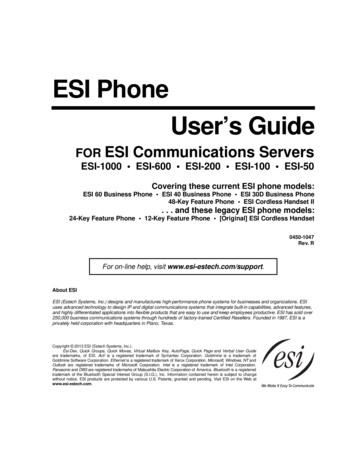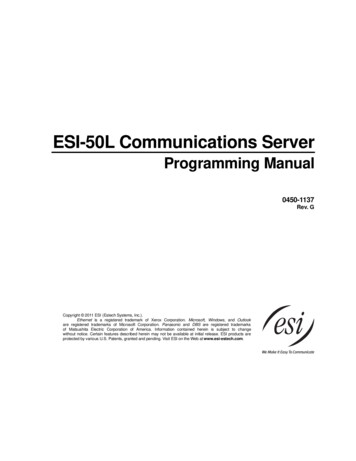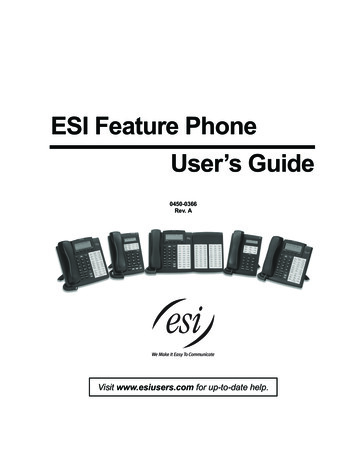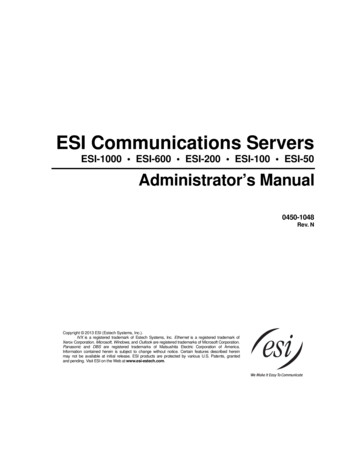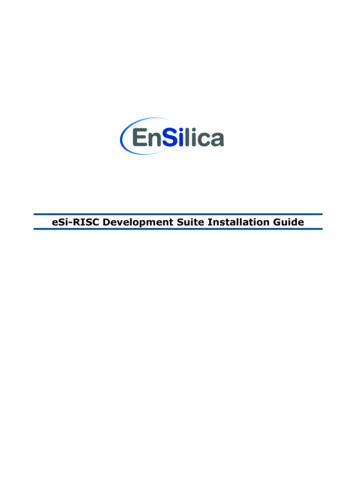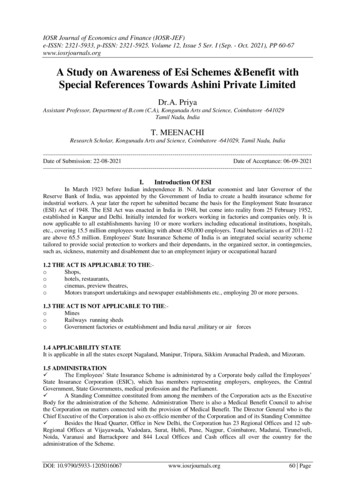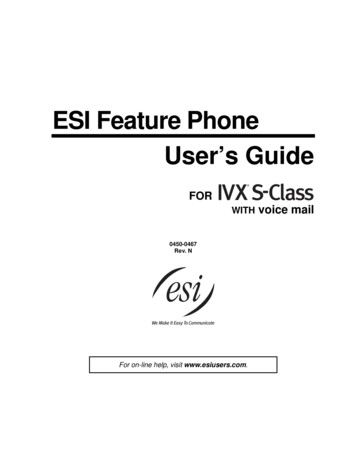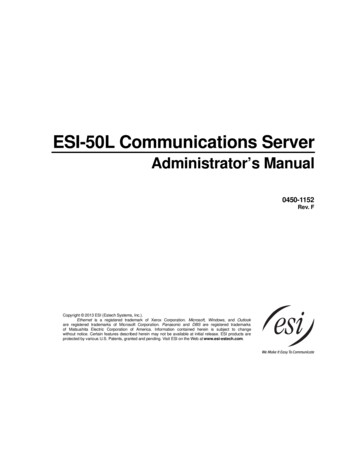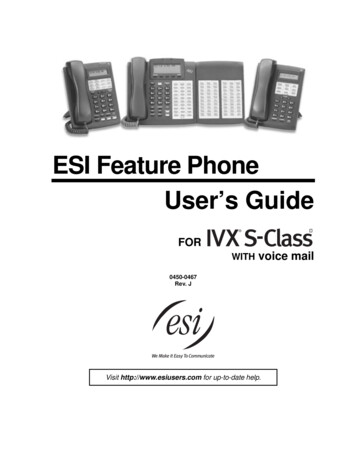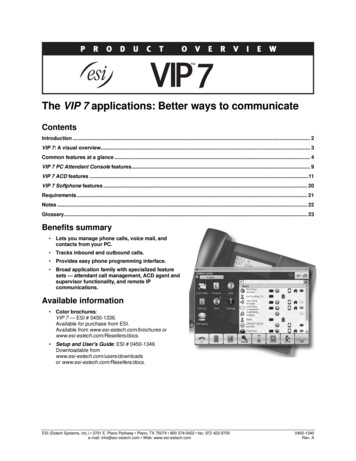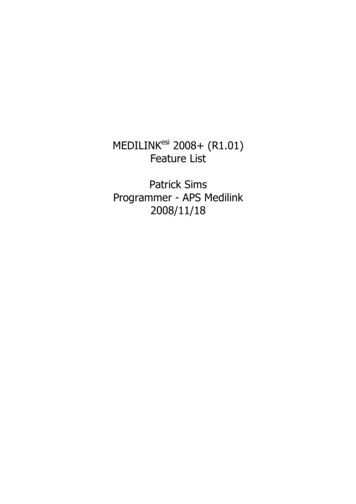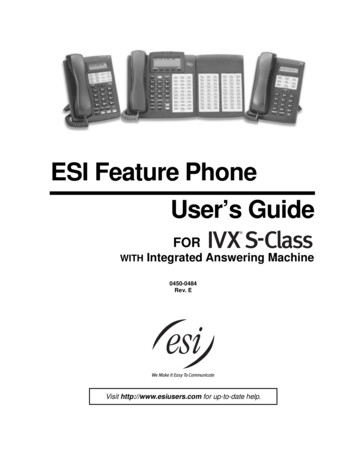
Transcription
ESI Feature PhoneUser’s GuideFORWITHIntegrated Answering Machine0450-0484Rev. EVisit http://www.esiusers.com for up-to-date help.
About ESIESI (Estech Systems, Inc.) is a privately held corporation based in Plano, Texas. Founded in 1987, ESIdesigns and builds innovative telecommunications products for businesses like yours. Because of theirpowerful combination of value and features, ESI products are consistently recognized by industrypublications and leaders.Copyright 2005 ESI (Estech Systems, Inc.).IVX is a registered trademark, and Esi-Dex, Integrated Answering Machine, Quick Groups, Quick Moves, Virtual Mailbox Key,AutoPage, Quick Page and Verbal User Guide are trademarks, of ESI. CompactFlash is a registered trademark of SanDiskCorporation. Act! is a registered trademark of Symantec Corporation. Goldmine is a trademark of Goldmine Software Corporation.Microsoft, Windows, NT and Outlook are registered trademarks of Microsoft Corporation. Panasonic and DBS are registeredtrademarks of Matsushita Electric Corporation of America.Information contained herein is subject to change without notice.ESI products are protected by various U.S. Patents, granted and pending.ESI is an ISO 9001-certified company. Visit ESI on the Web at www.esi-estech.com.
Table of contentsIntroduction.A.1What it covers.A.1How it’s arranged .A.148-Key Feature Phone .A.224-Key Feature Phone .A.412-Key Feature Phone .A.5Connecting your ESI phone .A.6Help mode (Verbal User’s Guide).B.1User programming: An introduction.C.1User programming menu .C.1Integrated Answering Machine operation .D.1Introduction .D.1Greetings.D.1Leaving messages . . .D.2Off-premises “reach me”.D.2Message retrieval.D.2Off-premises message delivery .D.5Message Recycle Bin (un-delete).D.6Status Indicator lamp .D.6ESI Feature Phone operation.E.1Display.E.1Caller ID .E.1Keys.E.1Dial tone .E.3Basic phone use.E.3Direct station selection.E.4Transferring an outside call . . . .E.5Conference calling .E.6Call forwarding.E.6Call waiting.E.7Hold/exclusive hold operation .E.8Paging .E.10Call pickup.E.10Optional feature .E.10Special keys . F.1FLASH, REDIAL, RELEASE . F.1Esi-Dex. F.2Override ring . F.9Message monitor mode (live call screening) .F.10Greeting reminder .F.10Headset operation.F.10Outside dial tone preference .F.11Line keys.F.11Optional features .F.12Analog stations. G.1Placing calls . G.1Transferring calls . G.1Call forwarding. G.2Call waiting. G.2Call hold . G.2Paging . G.2Call pick-up . G.3Voice mail operation from an analog station. G.3Analog station programming . G.5Select greeting (Master Station user only) . G.5Password. G.5Off-premises message delivery . G.6Message Recycle Bin (un-delete). G.7
(This page included for pagination purposes only.)
User’s GuideIntroductionIntroductionAccessing the rich ESI feature set is simple and easy through the straightforward design of ESI FeaturePhones. Each feature has been designed for ease of use while providing capabilities needed in anadvanced business phone. As for the IVX S-Class phone system itself, its Integrated AnsweringMachine functions like a traditional answering machine but with additional, special features.You’ll be able to learn many of the features simply by using your phone; and this User’s Guide willintroduce you to the wide variety of features offered by your ESI phone system and how to use yourphone effectively to achieve maximum benefits.What it covers 48-Key Feature Phone 24-Key Feature Phone 12-Key Feature Phone 60-Key Expansion Console (for use with only the 48-Key Feature Phone)How it’s arranged Section A — Introduction and Phone Illustrations Section B — User help Section C — User programming Section D — Integrated Answering Machine operation Section E — Phone operation Section F — Special keys and features Section G — Analog Stations IndexA.1
IntroductionUser’s Guide48-Key Feature PhoneThe 48-Key Feature Phone has a variety of programmable and built-in features. Additionally, itsupports the optional 60-Key Expansion Console. The 48-Key Feature Phone’s built-in voice mailfeatures and voice prompts make it easy to program and use.Status indicatorlamp (pg. D.6)3-line, 56-character displayPROGRAMfeature key(pg. C.2)Volume/scroll keys(pg. E.2)ESI-DEXfeature key(pg. F.2)HELP key foraccess to VerbalUser Guideand tutorial(pg. B.1)Context-specifickey to selectdisplayed optionsSpeakerVOICE MAILkey (pg. D.1)P/UP(pickup) key(pg. E.10)RECORD key30 programmablefeature keys(pg. C.2)Fixed feature keys(pg. E.1)Hint:A.2Microphone forbuilt-in speakerphonePAGE key(pg.E.10)On any of these phone varieties (including the 60-Key Expansion Console), you can perform directprogramming by holding down a programmable feature key for at least two seconds (similar to how youmight program a car radio button). This isn’t applicable to the fixed feature keys which, as their nameimplies, are already programmed.
User’s GuideIntroductionOptional 60-Key Expansion Console for use with the 48-Key Feature PhoneThe 60-Key Expansion Console adds 60 more programmable feature keys to your 48-Key Feature Phone.You program the Expansion Console’s keys just as you do the programmable feature keys on your ESIFeature Phone, using either direct or traditional programming (see pages C.2).Note: Only one key can exist per extension, feature or operation. If you program a second key for the sameextension, feature or operation, this automatically erases the first key so programmed, thus making itavailable for a new extension, feature or operation.Hint:You may find it easier to write in the names on the overlay before you program the keys and attach theoverlay to the Console.60 programmablefeature keys(pg. C.2)in two banksof 30 eachHint:On any of these phone varieties (including the 60-Key Expansion Console), you can perform directprogramming by holding down a programmable feature key for at least two seconds (similar to how youmight program a car radio button). This isn’t applicable to the fixed feature keys which, as their nameimplies, are already programmed.A.3
IntroductionUser’s Guide24-Key Feature PhoneThe 24-Key Feature Phone has a variety of programmable and built-in features. The 24-Key FeaturePhone’s built-in voice mail features and voice prompts make it easy to program and use.Volume/scroll keys (pg. E.2)Status indicator light (pg. D.6)2-line, 32-character displayESI-DEX feature key(pg. F.2)12 programmable feature keys(pg. C.2)SpeakerVOICE MAIL feature key(pg. D.1)P/UP (pickup) key(pg. E.10)PAGE key (pg. E.10)PROG/HELPfeature keyfor phone programmingas well as accessto Verbal User’s Guideand tutorial (pg. B.1)RECORD fixed feature keyMicrophone forbuilt-in speakerphoneFxed feature keys(pg. E.1)Hint:A.4You can perform direct programming by holding down a programmable feature key for at least twoseconds (similar to how you might program a car radio button). This isn’t applicable to the fixed featurekeys which, as their name implies, are already programmed.
User’s GuideIntroduction12-Key Feature PhoneThe 12-Key Feature Phone includes the basic, most commonly used phone features.Volume/scroll keys (pg. E.2)1-line,16-character displaySpeaker9 programmablefeature keysP/UP (pickup) key(pg. E.10)PROG/HELPcombo fixed feature keyfor phone programmingas well as accessto Verbal User’s Guideand tutorialPAGE key (pg. E.10)Fixed feature keysNote: Certain special features, including Esi-Dex (see “Special keys,” pages F.1–F.13), are not available onthe 12-Key Feature Phone.Important:Hint:A VOICE MAIL key, CONFERENCE key, and MUTE/DND key must be set on one of the nineprogrammable feature keys to utilize those features.You can perform direct programming by holding down a programmable feature key for at least twoseconds (similar to how you might program a car radio button). This isn’t applicable to the fixed featurekeys which, as their name implies, are already programmed.A.5
IntroductionUser’s GuideConnecting your ESI phoneUse the diagram (below) to connect your ESI phone. Each diagram represents the panel on thephone’s underside.Note: The “Top of phone” and “Bottom of phone” references in this diagram shows the correct verticalorientation of the phone — i.e., the part with the display is the top.12-Key Feature Phone24-Key Feature PhoneHandsetLine cordto wall[Headsetjack](TAPI)To PC Connects like a basic phone. Handset plugs into right-side jack. Line cord plugs into left-side jack.48-Key Digital Feature PhoneIn addition to how the 24-Key Feature Phone connectsto the handset and line cord, note the following:1 Headset jack. TAPI version includes a cable for connecting to yourPC’s serial port.Line cordto wallTo 60-KeyConsoleHandset 60-Key Expansion Console cable (included with eachConsole) uses standard RJ-11 telephone connectors.Note: Use the wall mount hook (located under the handset) when the phone is in the furthest upright position.1If shipped after March 1, 2004.A.6
User’s GuideHelp mode (Verbal User Guide)Help mode (Verbal User’s Guide)Your ESI phone system’s help mode (also called the Verbal User Guide) — a carefully conceivedcombination of spoken information, display readouts and even key illumination when appropriate — is apowerful tool to help you learn how to use the system’s many features.TutorialWhen your station is idle, press HELP, and then follow the spoken help menu to: Learn how to use the phone Hear a description of how any key is used Learn how to use voice mail features Hear a complete tutorial on phone operationHelp during station programmingTo hear a detailed description of a function you wish to program, press HELP while programming it.Help during a callPress HELP while on a call and this will place the call on hold, whereupon you can use help mode tohear a description of the function you wish to perform. When you exit help mode, you will bereconnected to the call.While you are either in help mode or programming your phone, your station will be temporarily placed inDND (see “MUTE/DND,” page E.2). Anyone calling your station while you are in DND will be forwardedto the Integrated Answering Machine (or other destination set by the Installer).Exiting help modeTo exit help mode, simply hang up.Visit www.esiusers.com for up-to-date help.B.1
Help mode (Verbal User Guide)User’s Guide(This page included for pagination purposes only.)B.2
User’s GuideUser programming: An introductionUser programming: An introductionThe answering machine can record up to two simultaneous calls. When a message is left, theVOICE MAIL key on the 12, 24, or 48-Key Feature Phone will light. Messages can be retrieved byany authorized 12, 24, or 48-Key Feature Phone or remotely from an off-premises location. Only oneuser can access the mailbox at a time. The system can also be programmed to call an off-premisesnumber to deliver messages.The first member in the Master List is allowed to program the Integrated Answering Machine via thePROGRAM key. This station is designated as the Master Station. All other users will only be able toplay and delete messages. A 12, 24, or 48-Key Feature Phone can be installed on an extension in theMaster Lst. However, a 24 or 48-Key Feature Phone must be on the extension designated as theMaster Station.Voice prompts will play menu and sub-menu options to access the desired feature. You don't have to waitfor the entire prompt to be played. Therefore, once you’ve become familiar with the prompts (consult“User programming menu,” below), you can quickly set any frequently used feature.Programming helpDuring any of the programming steps, press HELP to hear a more detailed description of the featureand related programming options.Exiting programming modeTo exit programming mode, simply hang up.User programming menuOverviewNote: Only menu options 2, 3, and 4 (except for personal greeting reminder) are available to non-Master users.1 Select personal greeting1 Record2 Delete3 Hear4 Station audibles1 Station ring tone2 Station ring volume3 Message ring2 Programmable feature keys(Station keys, line keys, speed-dial keys, otherfeature keys)5 Password1 Enter2 Delete3 Hear4 Security level3 Station options1 Call waiting/background announce2 Personal greeting reminder13 Headset operation4 Outside dial tone preference5 Hands-free answer6 Message monitor6 External message notification1 Delivery options2 Phone delivery3 Pager notification9 Un-deleteNote: Background announce and selections 3, 5, and 6 under station options are not available on a 12-KeyFeature Phone.1Not necessary with Generation II system. If unsure which system you have, consult your System Administration.C.1
User programming: An introductionUser’s Guide1 Select personal greetingSelect the desired greeting — 1, 2 or 3. The system will play the current greeting, followed byprompts to re-record, delete or hear again — or select the current greeting by pressing #.1Record personal greetingBegin recording at the tone. Press 1 to stop. The new personal greeting automatically replacesthe previous greeting.2Delete personal greetingWhen prompted, press 2 again to confirm deletion.Warning:3The mailbox is disabled if no greeting exists. Never delete all of the existing greetingsbefore you record at least one new one.Hear current personal greeting2 Programmable feature keysThere are two methods for programming your phone: Direct programming — Select the key you want to program, and hold it down for at least twoseconds. This not only initiates programming but also lets you immediately program that specific key.Direct programming example:You wish to set one of the keys to dial a co-worker, whose extension is 105. Hold down thekey for at least two seconds. This automatically puts you in feature key programming.Follow the prompts to enter 1 0 5. (This has allowed you to skip two steps — pressingPROGRAM and selecting a menu option — that you’d have had to perform if usingtraditional programming.) Traditional programming — Press PROGRAM. The Verbal User’s Guide will speak to you,walking you through the full menu, during which you can choose the appropriate option.How the programmable feature keys can be set Line keys — If a line number (1 through 12) is programmed, the programmable feature keybecomes a line key providing the appropriate lamp information and manual outside-line access. Station keys — If the dialed digits input are a three-digit number, the programmable feature keywill become a station key, providing the appropriate lamp information and easy access ortransfer. Three-digit numbers you enter can be:— User extensions (100–123 and 124–129)— Department numbers (290–299)— System speed-dial numbers (600–699) Speed-dial keys — In addition to programming a programmable feature key with a systemspeed-dial number, you can create personal speed-dial keys for automatic dialing of frequentlycalled outside numbers. If you program 9 (or 8 or 7) plus a phone number, the programmablefeature key becomes a speed-dial key. When you program a speed-dial key, there's no need toinsert a pause after the 9 (or 8 or 7). The speed-dial number can be up to 24 characters long.Use the up scroll key ( ) to enter special characters in a dial string (see Option 6 on page C.4). Other feature keys — If you enter feature codes, the programmable feature key will serve as anenable/disable key for that feature. The Installer may have programmed certain stations foraccessing additional features; consult your System Administrator for your access (see page F.12).C.2
User’s GuideUser programming: An introductionKeys’ LED activity during programmingKey type and LED indicationModeStation key orVirtual Mailbox KeyLine keyFeature keyor speed-dial keyFlashing redFlashing greenFlashing amberFlashing redFlashing redFlashing redBlinking redBlinking greenBlinking amberSolid redSolid greenSolid amberOffOffOffCurrently being programmed andpreviously assignedCurrently being programmed andpreviously unassignedProgramming mode — Was assigned orviewed in current sessionAssigned in a previous programming sessionand not yet viewed in current sessionNever assigned and not yet viewed in currentsession3 Station optionsThe station options sub-menu (PROGRAM 3) lets you activate or deactivate several features yourstation can provide. At each option sub-menu, 1 enables the option and 0 disables it. (Each optionlisted below is explained elsewhere in this manual, as noted.)1Call waiting/Background announceSee page E.7 for call waiting and page E.8 for background announce.2Greeting reminder (Master station only)See page F.10.3Headset operationSee page F.10.14Outside dial tone preferenceSee page F.11.5Hands-free answerSee page E.2.6Message monitorSee page F.10.Note: Background announce and selections 3, 5, and 6 are not available on a 12-Key Feature Phone.1Not necessary with Generation II system. If unsure which system you have, consult your System Administration.C.3
User programming: An introductionUser’s Guide4 Station audiblesThe station audibles programming provides control of the following audible items:1Station ring toneYou can select from six possible tones to help distinguish it from other nearby ringing phones.Press or to select a tone, then press # to accept it.2Station ring volumePress3andto set the desired ringer volume (range: off to high), then press # to accept it.Message ringWhen enabled, this feature will periodically generate a short ring tone at your station as anadditional alert that you have new messages.5 Password1Enter new passwordYour password may consist of 2–8 digits followed by # (0 cannot be the first digit). Entering only0 as the password will turn off the password requirement.2Delete current passwordResets the password to the default password.3Hear current passwordDisplays and plays back the current password.4Password security levelSelection012C.4ResultNo password required for access from any phonePassword required only for remote access, either off-premises or from otherstations within the systemPassword always required
User’s GuideUser programming: An introduction6 External message notification12Delivery options1Delivery to phone number only2Notify pager only0No off-premises deliveryPhone delivery1Enter phone numberEnter the phone number (24 digits, maximum) followed by #. Do not include an outside lineaccess code (i.e., don’t add 9, 8 or 7) before the number.To insert a special character, press the right scroll key ( ) to select the desired specialcode: # , , F or P. Press # to confirm the inserted character and continue. Press # # tocomplete the entry.Code# FPWhat it produces# DTMF tone DTMF toneFlash hook2-second pauseUse the down arrow key ( ) to backspace.Once the number is saved you can use the scroll keys to move back and forth to view thenumber. To edit the number, you must delete it and enter the correct number.2Delete phone numberDeletes the currently programmed phone number.3Display current phone numberDisplays the currently programmed phone number.(Continued)C.5
User programming: An introduction3User’s GuidePager notification1Enter pager numberEnter the pager number (24 digits, maximum) followed by #. Do not include an outside lineaccess code (i.e., don’t add 9, 8 or 7) before the number.To insert a special character, press the right scroll key ( ) to select the desired specialcode: # , , F or P. Press # to confirm the inserted character and continue. Press # # tocomplete the entry.Code# FPWhat it produces# DTMF tone DTMF toneFlash hook2-second pauseUse the down arrow key ( ) to backspace.Once the number is saved you can use the scroll keys to move back and forth to view thenumber. To edit the number, you must delete it and enter the correct number.2Delete pager numberDeletes the currently programmed pager number.3Display current pager numberDisplays the currently prog
Visit www.esiusers.com for up-to-date help. Help mode (Verbal User Guide) User’s Guide B.2 (This page included for pagination purposes only.) User’s Guide User programming: An introduction C.1 User programming: An introduction The answering machine can record
